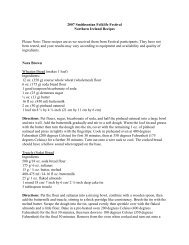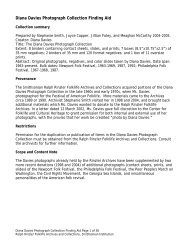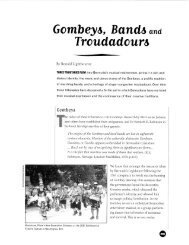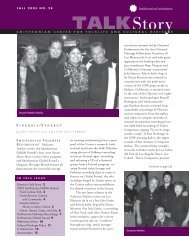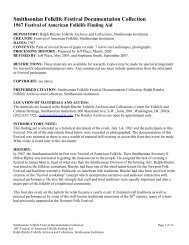Who Owns Traditional Medical Knowledge? - Smithsonian Center ...
Who Owns Traditional Medical Knowledge? - Smithsonian Center ...
Who Owns Traditional Medical Knowledge? - Smithsonian Center ...
You also want an ePaper? Increase the reach of your titles
YUMPU automatically turns print PDFs into web optimized ePapers that Google loves.
MAKING HERITAGE LEGIBLE 179<br />
position to regulate and control its harvest. But then an unexpected player entered<br />
the conversation: the state forest department, which officially controls and regulates<br />
the forest area. Although it had contributed no material or finances to the<br />
research effort, the forest department demanded a share of the license fee and<br />
royalties on the grounds that the plant material collected is endemic to the forest.<br />
The TBGRI was forced to renegotiate the terms of the agreement to include the<br />
forest department, all of which further cut back into the profit share received by<br />
the Kanis.<br />
The main outcome was that even though the original benefit-sharing agreement<br />
fell apart, the drug manufacture continued as planned. In other words, this<br />
state-sponsored heritage compensation scheme, which relied on tribal medical<br />
knowledge without consent from the Kanis, did not ultimately disturb the market<br />
production and circulation of this Ayurvedic drug to national and even international<br />
markets. Thus, the payments continued to be made into the Trust, but<br />
from all accounts, the Trust itself lost any legitimacy to distribute the funds to its<br />
constituents. The Kani now seem to want to choose their own future vis-à-vis<br />
their medical heritage. Eight years after the benefit-sharing agreement was signed,<br />
the manufacturing license expired in August 2006. Fueled by NGO critiques that<br />
the benefit-sharing arrangement by TBGRI essentially traded and privatized the<br />
common heritage of humanity, Kani pancayat leaders are now aware that they could<br />
have denied both access and consent to TBGRI researchers. In a fitting end to the<br />
story, Kani pancayat leaders— along with a representative group of all the tribal<br />
healers, or Plathis—have announced that they will not renew the license with Arya<br />
Vaidya Pharmacy. 68 Instead, they have announced plans to float a factory themselves<br />
with the combined help of all three pancayat bodies, instead of privatizing<br />
their medical knowledge to cultural outsiders whose drug manufacture stands to<br />
make a profit from their heritage.<br />
The postscript to this story is almost apocryphal. Through the entire decade<br />
of research and organization, neither TBGRI nor any other agency of the government<br />
thought to secure an international trademark or a product patent that<br />
could be valid in international markets. In the interim, a leading U.S. food supplement<br />
manufacturer and vitamin store chain, the Great Earth Companies,<br />
Inc., managed to seize the opportunity and secure trademark rights for Jeevani<br />
(the name under which it had first been marketed in India). Great Earth<br />
Companies now uses Jeevani in its widely marketed product Jeevani Jolt 1000<br />
without technically infringing on the IPRs of the original drug. 69 This perhaps<br />
is the ultimate irony. After eight years of research that relied on Kani tribal<br />
knowledge, and a benefit-sharing arrangement that was touted as a model compensation<br />
scheme to “give back” equitable returns to the South, Jeevani is now<br />
available in the west as an energizer, antistress adaptogen, and immune system<br />
supporter for a mere $21.99 for 60 capsules. TMK and medical heritage, it<br />
seems, can always be discovered, commodified, and owned far from its place of<br />
origin.



